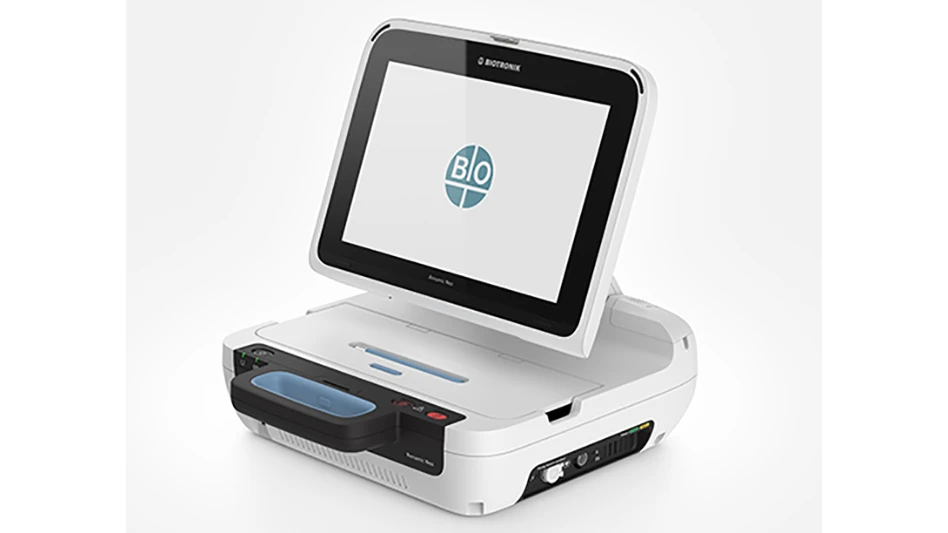
SCHURTER/BIOTRONIK
For more than 50 years, BIOTRONIK has been developing medical devices that improve the quality of life of patients suffering from cardiovascular and endovascular diseases. One of the company's products is the Renamic Neo, a control unit that communicates with a medical device implanted in a patient, such as a pacemaker. The control unit allows the physician or patient to read out information such as battery status, heart rate and other parameters important to the functioning of the implanted device. In developing this application, specific knowledge of SCHURTER played an important role. In conversation with Willem Zoeten, account manager at SCHURTER, and Product Development Engineer Paul Berning.
The RenamicNeo is the world's first device that can read and program the implant completely wireless, which is why the low electromagnetic radiation of the SCHURTER components is essential.
Communication between the Renamic Neo and the implanted device takes place wirelessly, via a low-power radio signal. It’s essential that there is no interference in the frequency range of this signal. When developing the application, EMC was therefore an important issue from the start, says Berning: "In a special emission-free EMC chamber at BIOTRONIK, we tested a number of controller types to see which solution had the lowest emission. We also tested and optimized the other components, such as the LCD display, in this way. Finally, we developed prototypes with the best-performing components, which were also tested at BIOTRONIK. Particularly good, was the verdict."
When the Renamic Neo went into production, BIOTRONIK asked SCHURTER to include an EMC test as standard in the production process. Berning: "BIOTRONIK wanted to officially measure that their products met the medical EMC standard EN 60601-1-2 and supplied the equipment to do so. There’s now a shielded cabinet here, where no radiation can penetrate from the outside. The product is placed in the cabinet, connected with cabling, and switched on. An antenna in the cabinet captures all signals around the frequency in question, and these go through a coax cable to a spectrum analyzer outside the cabinet, which measures the signals. An algorithm determines an average value for these signals, which must lie between 3dB and 20dB."
"Thanks to the knowledge we have of EMC, combined with our expertise in the field of control panels, we were able to make a significant contribution in this project. BIOTRONIK has a lot of knowledge about EMC, we brought in a lot of expertise to come up with a producible product. Based on the requirements set by BIOTRONIK, we redesigned the entire PCB. All to ensure that you are exposed to as little emission as possible," Zoeten says.
The application has now been in production for two years.
"At the moment, we are supplying pre-series quantities; we are eventually aiming for a production volume of a few thousand per year. Now it’s a question of fine-tuning the production process, where we look in particular at the cost structure. Is there anything else we can improve in terms of production technology? Can we use other materials or production methods to reduce costs? Each saving is directly passed on to BIOTRONIK. We have already been able to reduce production costs by more than 20% per unit over the last two years, and we are still working on further improvements," Zoeten says.
The continuous optimization of materials and production processes is a permanent feature at SCHURTER, Zoeten explains: "We have to offer products like this competitively, but at the same time the risk is high at the beginning. That's why it helps if we know in advance that we can make efficiency improvements along the way."
Latest from Today's Medical Developments
- Arcline to sell Medical Manufacturing Technologies to Perimeter Solutions
- Decline in German machine tool orders bottoming out
- Analysis, trends, and forecasts for the future of additive manufacturing
- BlueForge Alliance Webinar Series Part III: Integrate Nationally, Catalyze Locally
- Robot orders accelerate in Q3
- Pro Shrink TubeChiller makes shrink-fit tool holding safer, easier
- Revolutionizing biocompatibility: The role of amnion in next-generation medical devices
- #56 Lunch + Learn Podcast with Techman Robot + AMET Inc.





